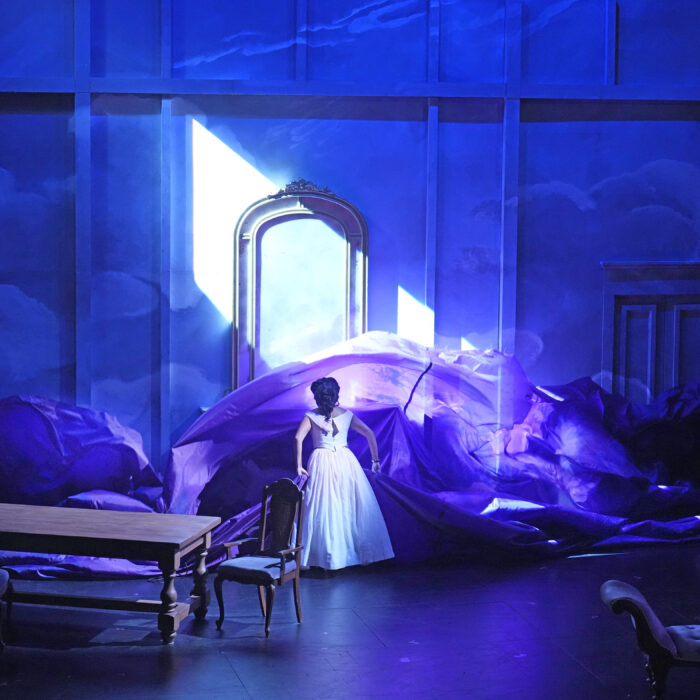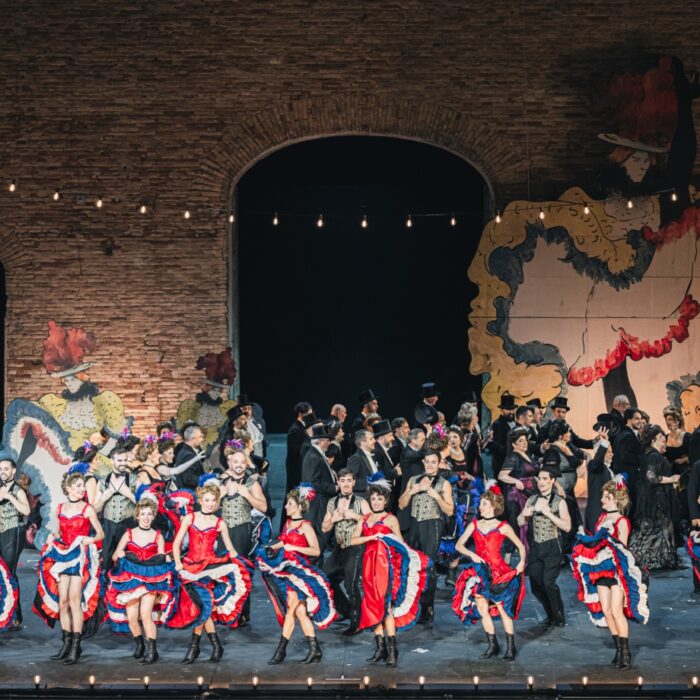
Royal Opera House 2017-18 Review – La Bohème: Matthew Polenzani, Maria Agresta & Company Trapped In Camp Direction
By Sophia LambtonThe word “Bohemian” – much like the popular terms “retro,” “Goth,” or “vintage” – is yet another label that has offered countless inferences over a plethora of different times. The “Bohème” clique of Puccini, undercut by the whimsy and exuberance of Italian verismo, would contrast with a play rendition of its source, Henri Murger’s “Scènes de la Vie de Bohème.” Bohemian niches across modern adaptations of the tale – whether in 1990s New York or 1930s Berlin, as one opera director located it – vary but have one thing in common: style. Some are more anarchical than others; some are more conventionally artistic. But if both aesthetic and artistic principles didn’t unite the members of Bohemian clans, they wouldn’t be a part of any group – but rather lone artistic outliers.
What Style?
In Richard Jones’ 2017 Royal Opera production of “La Bohème” – already being performed here in its first revival – little sets Rodolfo, Mimì, Musetta, Marcello and the gang apart from others, except immature behavior. While there’s no doubt that these characters all frolic, mess around and tease each other in the opera, in this instance their comportment overrides not just the plot but ambiance of the libretto. The first time Mimì enters, she doesn’t so much faint from her consumption as lie down deliberately. Rather than being alarmed, Rodolfo regards the audience humorously, commedia dell’arte style – as though to ask them what he ought to do. It’s less “Bohème” than it’s “Il Barbiere di Siviglia” – an opera in which all of the main characters are constantly explaining schemes-in-progress to the audience.
During Musetta’s statement of revelry, “Quando m’en vo,’” she staggers and hobbles, appearing not so much sexy as drunk. After several stumbles and collisions with the Café Momus clientele, she clumsily removes her underwear and throws it at a stranger. Not only does the character appear naïve – but we as the spectators seriously begin to doubt why someone like Marcello would be so addicted to this woman. While it is necessary to maintain the humor through the work – the opera isn’t sunk as low in melodrama as “La Traviata” or most Verdi works – too many instances entrench it in the sphere of farce, snipping away at feelings of nostalgia and desperation to create a new mold.
While the Movement Director (originally Sarah Fahie, in this revival, Danielle Urbas) inhibits the singers’ liberty of artistic expression by guiding their gestures and gait, the set itself appears to have emerged out of a pop-up book. These artists inhabit a loft shaped like the top half of an octagon. Rather than dimming the lights or lowering the safety curtain to allow for its movement and the transition of scenes, we watch as stage-hands roll it on its wheels and place it at the forefront. Similarly, as three Parisian arcades appear in the second act, we see first their undecorated backs, then their intentional fronts. The result is a perception of squeaking, creaks, and muffled sounds that manage to transcend the power of the orchestra. We the audience appear to be watching a production in progress – not an accomplished spectacle.
Though Nikki Bird’s costumes create an ensemble that makes for a motley façade, the Bohemians’ living quarters are conspicuously bland. Marcello is a painter, Rodolfo a poet; yet we see no pictures, no easels, no sheets of paper, books or magazines; no clutter whatsoever. It’s a wonder that these scrappy, young artistic bachelors can live so neatly in an atmosphere of neutral beige.
Not What You’d Expect From Mimì & Rodolfo
Matthew Polenzani has the vocal gifts to realize an unconventional Rodolfo; the slender timbre of his tenor voice gives him a gentle vulnerability that easily conveys the writer’s anguish and timidity – contrasting boldly with traditional, Italian versions of the character that can seem gallant and bombastic. Frequently, however, an overzealous desire to express himself filters his voice, prompting him to almost whisper ends of phrases or else soften them so that they sound almost inaudible. Struggling a little in some top notes – like the high C of “speranza” in “Che gelida manina” – he has a tendency to render certain sounds falsetto so as to accentuate the sentiment.
Possessing a timbre closer to a dramatic than a lyric soprano, Maria Agresta stuns the audience by lending Mimì her dark-colored, low-lying, cavernous voice. At first, it is almost alarming to hear the fragile Mimì with such powerful resonance – but Agresta knows well how to mold her voice into a gentler, thinner sound. Her slow diminuendi and tender approach through “Sì, mi chiamano Mimì,” as well as the evident embarrassment she feels when confessing “Non vado sempre a messa” – “I don’t always go to mass” – ensures we’re looking at a nubile, inexperienced, harmless girl, even though her natural voice is more akin to feisty Leonora in both “Il Trovatore” and “La Forza del Destino.” Radiating humility throughout, she is contemplative when she sings words such as “Vivo sola, soletta” – “I live all alone” – and yet already more resigned, more learned in the third act when she parts with Rodolfo with the gradually softening “Senza rancor” – “No hard feelings.” Though there are certain moments when her vocal power overshadows Mimì’s fledgling qualities, of all the singers she is the most stylized.
More Unexpected Turns
Etienne Dupuis’ Marcello won’t allow his character to be the standard backdrop-baritone that features in most operas. Invariably apt at creating a mock-austere timbre in the first act when he makes fun of his painting and “bows” to King Louis Philippe, he exudes with equal conviction the sympathy and caution that come with warning Mimì after her split with Rodolfo, “Non fate scene qua” – “Don’t make a scene here.” Where appropriate, he easily lends his voice a thicker vibrato to generate the irascible effect of Musetta.
That Musetta is by far the most fenced-in by the domineering hand of the Movement Director – albeit most likely not willingly. With a register that far outstretches the role’s tessitura, Danielle de Niese lends the character a slender, young and girlish timbre; one that can easily imply a lack of worldliness. Although Musetta is notorious as a coquette, she’s also shrewd enough to realize that Marcello cowers underneath his obvious attraction to her. It is that cunning that is missing from de Niese’s interpretation – heavily physically influenced by direction and often yielding to playful shrieks of high notes and excessive staccato. Only in her final phrases when she orders Marcello to go find a doctor for the dying Mimì do we hear something earnest; a personality broader than an unfunny stereotype.
The opera’s inclusion of its only bass aria, “Vecchia zimarra, senti,” bodes well for Fernando Radó as Colline. Refusing to yield to pervasive nostalgia, he carries his well-sustained technique through a ceremonious approach to the old coat he is willing to sell to help Mimì recover. Duncan Rock’s Schaunard never misses a moment to effuse the young panache and brazen nature of his character through a full-bodied baritone that can be playful and still function with a well-employed technique.
Under the baton of Nicola Luisotti the orchestra easily tackles the transitions of jocose to severe and austere. With precise traditional tempi and rhythms, the strings swell in their effervescence just as easily as they subside. Light, staccato passages are jovial, flutes are cleanly played and most proportions of dynamics are well-calculated. Certain diminuendi could be more lengthily stretched out; certain attacks – like the strings that underpin Mimì’s “Mi grida ad ogni istante non fai per me,” when she complains to Marcello of Rodolfo’s mistrust – could be brusquer and sharper. Unfortunately, the brass begin to fall apart towards the end, just when solemnity must reach its summit at the point of Mimì’s death. Nevertheless, it is a handsome handling of the score.
Overall this production – much like the manifest squeaking and shuffling of props suggests – is more about the kind of presentation that it could have been than what it is. Despite moments of vocal uncertainty, all of the singers are capable of playing Bohemians in the aesthetic and emotional vein. It’s just that no one wants to dress them or their dwelling up that way.


